Various scenes from the Baruch Institute including the marsh, sampling platform and students collecting samples.
After a year that saw student housing empty and labs mostly quiet, the University of South Carolina’s Belle W. Baruch Institute for Coastal and Marine Sciences was buzzing again this summer, with graduate students, undergraduate interns and researchers from universities around the country working at the field lab near Georgetown, South Carolina.
Erik Smith, an associate research professor and manager of the North Inlet-Winyah Bay National Estuarine Research Reserve, says he was so glad to be working with students again in the lab, marshes and waterways that he might have even overlooked some administrative tasks this summer.
The Baruch Marine Field Lab and associated National Estuarine Research Reserve offers students a first-hand look at a beautiful but changing ecosystem — the chance to get a taste of fieldwork and perform research projects in the on-site labs. But the work they do does more than enhance the student experience; it also helps improve our understanding and management of marine and coastal resources.
“This is an educational opportunity for the students, but they are doing real work,” Smith says. “They are contributing to the research mission of the laboratory and helping us fulfill project obligations to the national Research Reserve system."
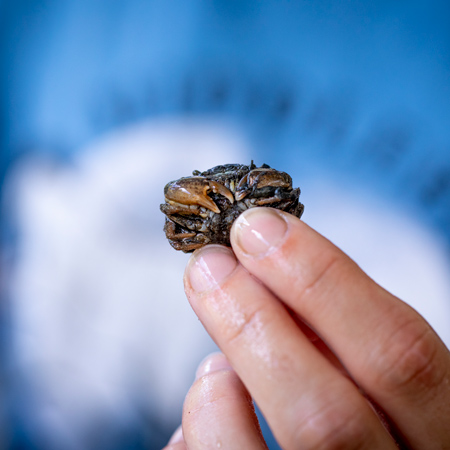
The Baruch Marine Field Lab gives students access to a marine ecosystem where they gain firsthand experience doing fieldwork.
Bill Strosnider, director of the Baruch Marine Field Laboratory, said this summer was particularly busy, with the dorms and the labs filled with resident graduate students and undergraduate interns. Along with the University of South Carolina, students came from the University of Dayton, Coastal Carolina University, the University of North Carolina at Chapel Hill, Georgia College, Clemson University, St. Francis University and Horry-Georgetown Technical College.
“It’s been a nice diversity of students — from two-year colleges to Ph.D. students. The conversations get interesting with marine science, environmental science, environmental engineering, mechanical engineering and biology majors all living together,” Strosnider says.
The students were able to share experiences and expertise, working with the four on-site faculty members along with other mentors on university campuses.
“One of the big things we do, consciously, is we make sure the students here don’t just work on their project with their adviser or faculty mentor. They’re pulled about once a week into someone else’s project to lend a hand. We think it helps students grow and get a fuller experience,” Strosnider says. “They get familiar with different kinds of work, get a taste of it. So later down the line, they’ll be even better prepared.”
And this year’s students took full advantage of the resources they were offered through Baruch and the College of Arts and Science.
“They’re really interested and smart, and that's almost always the case with our interns. But I feel like we got lucky this year,” Smith says. “They are very engaged in working together and helping each other out on projects. We really hit the jackpot this summer.”
Here’s a look at five UofSC students who spent their summer living and learning on the South Carolina coast.
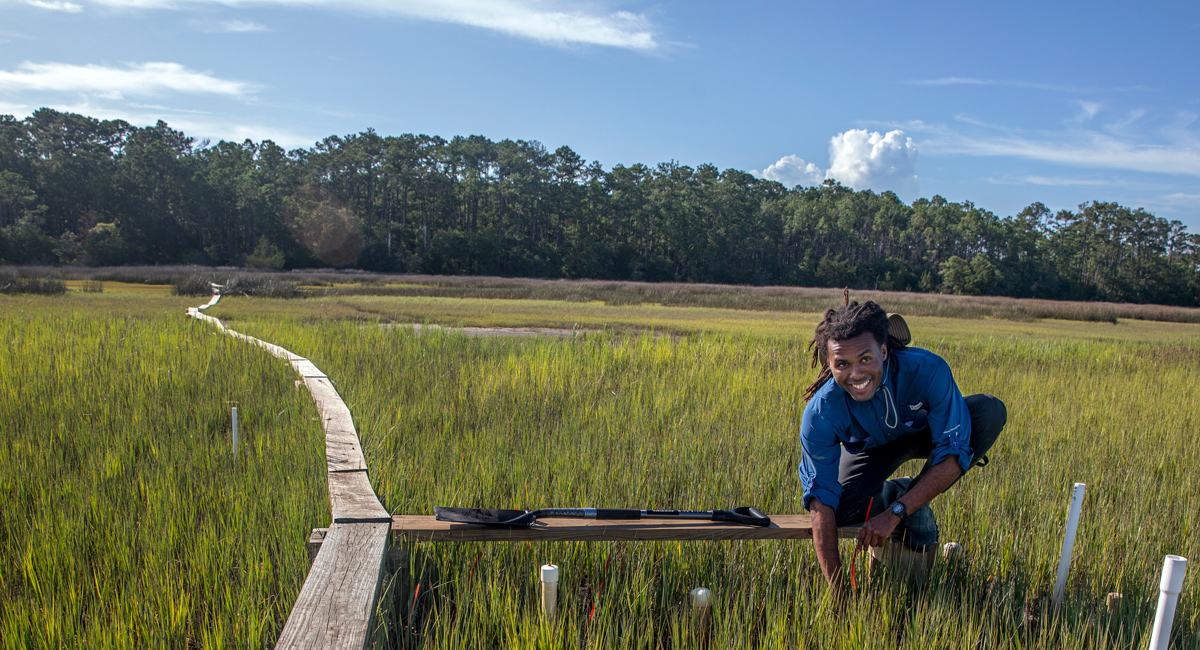
Kamari Boyd navigates the narrow boardwalk to take part in a global study of organic matter decomposition in salt marshes.
Kamari Boyd
As a child growing up in Columbia, Kamari Boyd’s parents weren’t big fans of cartoons on television, steering him instead to stations like Animal Planet, publications like National Geographic and to the outdoors.
“So, from a very young age, I always had an interest in the planet and photography and stuff like that,” says Boyd, a junior environmental science major.
He continued on that path this summer, when he spent his days navigating an 8-inch-wide boardwalk deep into the marshes at Baruch, shovel and bucket in hand, to take part in a global study of organic matter decomposition in salt marshes.
Boyd and his fellow researchers around the country planted “standardized” organic material — actually tea bags — throughout the high-, mid- and low-marsh. Over 90 days, they extracted those tea bags and analyzed them for carbon content and decomposition rate.
“We're still crunching numbers, but for the most part, we're trying to see if there's a correlation between tidal frequency and soil composition,” he said. “We’re doing this in order to get a better understanding of how the marsh is able to deal with decomposing matter.”
“Collaboration feels natural and organic around here.”
The national study is part of the examination of sea level rise. As the waters rise, the marsh adapts by accumulating soil. Understanding how tidal flooding impacts organic matter decomposition, and thus soil stability, will enable scientists to better understand how the marsh will respond to continued sea level rise.
It’s important — and relevant — work.
“The marshes are part of a lot of different things. It's a big part of the environment here. But also, economically, the marshes are home to a lot of animals that we require for seafood and commercial uses.”
And his summer gave him the chance for real-world fieldwork — in an area that has interested him for years.
“It's been a fantastic opportunity. And all the people that work here, all the undergrads and the other interns are super friendly and down to earth. It's really neat to have the ability to bounce ideas off of people who have similar interests with you, but also are doing slightly different things,” he says. “Collaboration feels natural and organic around here.”
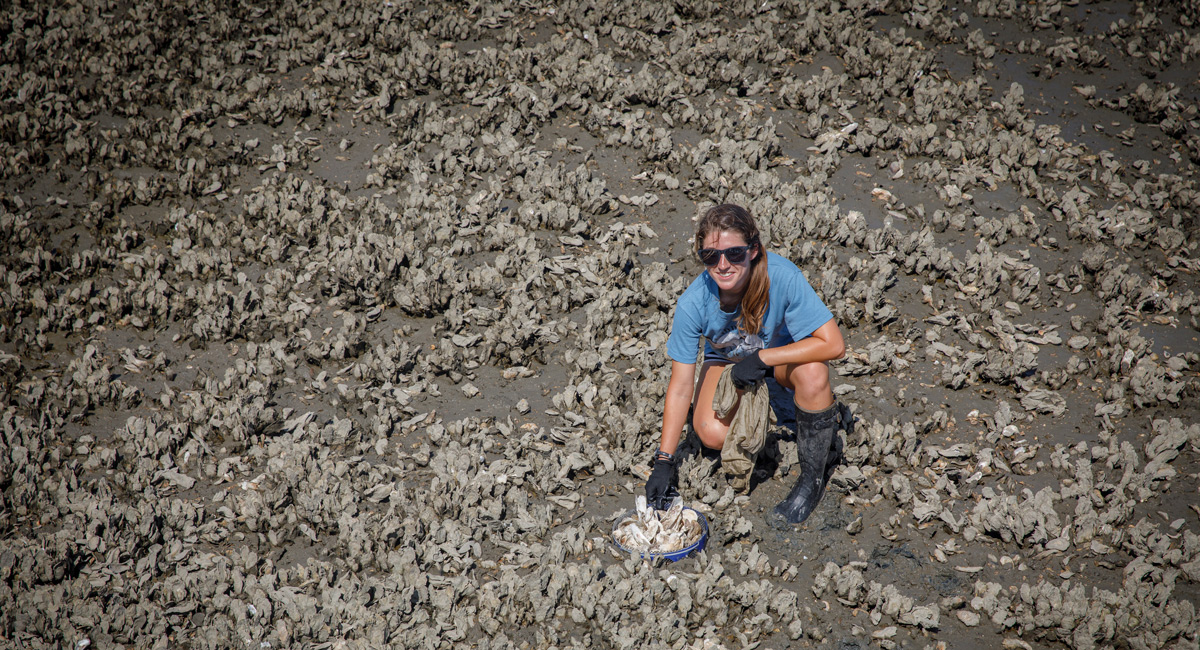
Maggie Pelton checks oyster beds in the marsh around Baruch.
Maggie Pelton
From donning thick boots and climbing down a ladder to retrieve oyster shells at low tide to analyzing the tiny animals found attached to those shells, Maggie Pelton found new ways to be inspired this summer.
“It's one thing to learn about a concept in the classroom and something completely different to actually be able to do it in real life. I learn a lot in class. But I think that this really solidifies the things that I've learned in class and makes them click in a different way than they ever have before,” says Pelton, a senior marine science major from Greenville who is a member of the South Carolina Honors College.
Much of Pelton’s work this summer looked at the different types of fauna — including crabs, shrimp and small fish — that live on oyster reefs. Baskets of clean oyster shells were placed among the reefs at four sites on the Baruch property, where they remained untouched for several weeks. As the tide rolled in and washed out, the once-pristine shells became coated with sediment and small creatures. The shells were collected and washed at the outdoor seawater lab, and a sieve was used to collect anything larger than a millimeter.
“We’re looking at the organisms that are using the oyster reef as habitat. They’re a foundation species so they’re really critical to this reserve and lot of estuarine habitats,” says Pelton, as she sprayed the shells with seawater pumped in from nearby Oyster Landing. “Once we have all of the different organisms, we'll take them back to the lab and weigh them, measure them, sex them and ID them. And then we have a couple of different measurements like salinity and dissolved oxygen, so you get a good picture of the community that the oyster reefs support.”
Pelton says the time spent working in the marshes and in the labs at Baruch has also made her next step clear.
“Before this summer, I was a little bit hesitant about grad school and whether or not I wanted to do research. But being here and doing this, it’s kind of changed my perspective about the work. I see that I really do love it,” she says. “It's just a really fun environment. And it's a good mix of being in the office and being able to do some of that kind of work, but also being in the field. It has just really piqued my interest.”
“This really solidifies the things that I've learned in class and makes them click in a different way than they ever have before.”
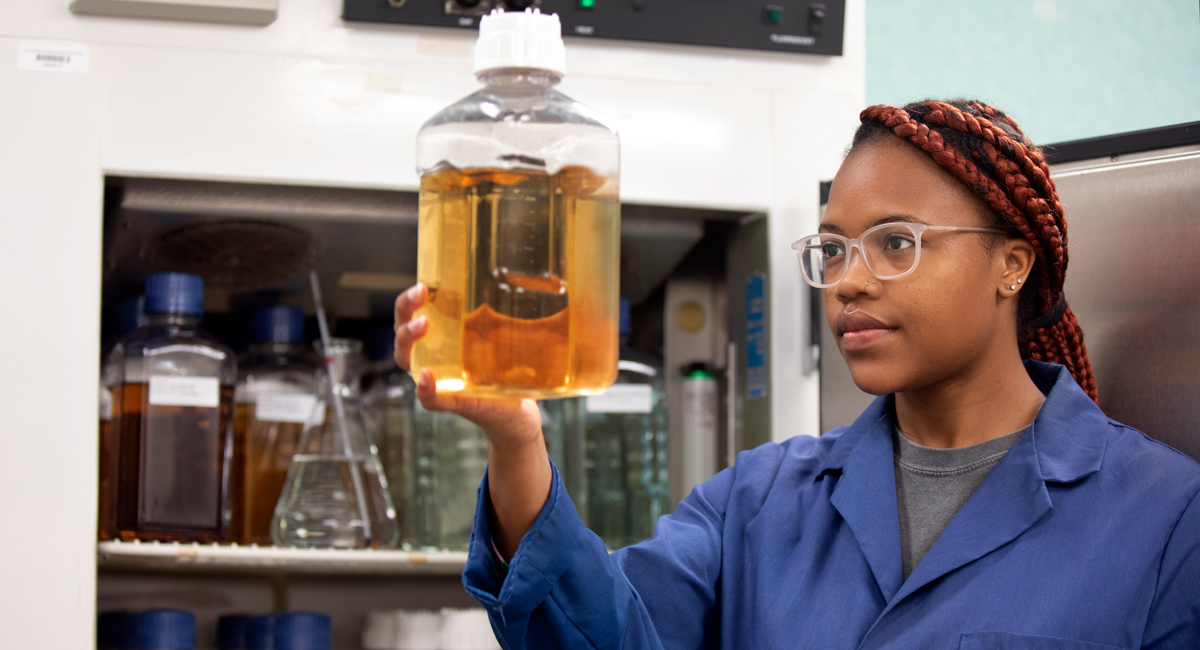
Ph.D. student Gwen Hopper analyzes the color properties of the dissolved organic matter in water samples she collected over the summer.
Gwen Hopper
As a second year Ph.D. student in analytical environmental chemistry, Gwen Hopper spent her summer collecting, testing and analyzing water samples from rivers, wetlands, creeks and stormwater retention ponds in the Winyah Bay watershed near Georgetown.
She believes her future will be in academia, which she sees as a way to never stop learning — and offers her the opportunity to be a role model.
“I like teaching. Even in elementary, middle and high school, I was always that student that tutored other students if they needed extra help,” said Hopper, who grew up in Kings Mountain, North Carolina, and earned her undergraduate degree from North Carolina State University.
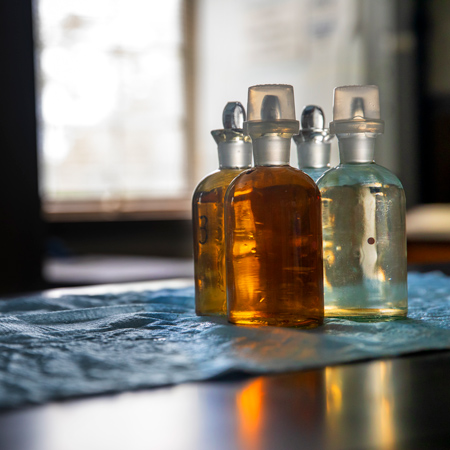
“Also, I didn't have a lot of African-American women teachers or professors growing up. And I feel like a lot of little girls and a lot of students from lower income communities are discouraged from going into those (science) fields because they're like, ‘Why would I try to do that? I don't see anyone that looks like me.’ I'd like to serve as a face for those kids, those students coming up. So ultimately, yes, I want to be a professor.”
But first she will continue her research, which is part of a broad survey to investigate how land use and development practices influence the type of dissolved organic matter exported to local waterways.
“We're trying to see if the structure and the rate of carbon degradation is related to the fate of the organic matter within the water. And that's important for things like global carbon cycling, because ultimately all of these different types of water that we look at are leading to the Atlantic Ocean,” she says.
This semester, she is back in Columbia with the hundreds of water samples she trucked to the Midlands from Baruch, where she will continue her analytical work and her classwork. When the samples are processed and the data is studied, she’ll figure out the gaps that need to be filled next summer — either at the Baruch lab or another site.
“USC has a lot of professors that do environmental research. And when you’re looking at environmental chemistry Ph.D. programs, a lot of those are atmospheric, and I wanted to do water. So that kept narrowing my search down more and more and more until I came to USC. It’s affordable; I have a fellowship here. And I have great professors.”
“We're trying to see if the structure and the rate of carbon degradation is related to the fate of the organic matter within the water. And that's important for things like global carbon cycling.”
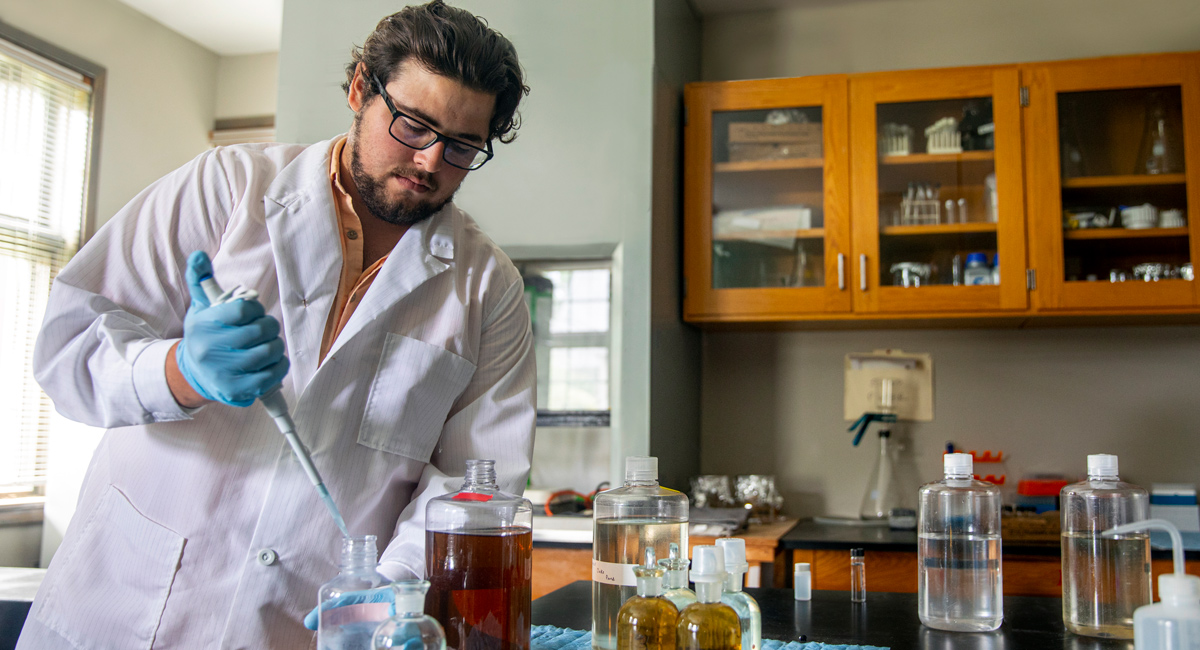
C.J. Szewczyk
Curtis “C.J.” Szewczyk was one of the few students who was able to do research at Baruch during the summer of 2020, when COVID-19 shut down most of the work at the site. He was back again this summer, continuing his work on dissolved oxygen levels in water.
It’s work he hopes to continue after he earns his master’s degree in marine science in December.
“I'd like to work within like a state agency or similar organization to continue working with water quality,” he says. “And I'd also like to get involved with citizen science or outreach. I want to be involved in the community and help bridge the gap between the general public and scientists, because I think that is a missing link that we could shine more light on.”
At Baruch, his research project looks at the Waccamaw River, a waterway with periodic low dissolved oxygen levels that discharges into Winyah Bay.
“Starting out, we were just broadly trying to address what is causing this dissolved oxygen impairment. And there are different factors. We hypothesized and we looked at temperature as a main driver, and we did a lot of that work last summer. This summer, we are focusing more on nutrient loading to the system,” he says.
Because of climate change, more and stronger precipitation events mean added nutrients will be loaded into the system, which may be causing the change in dissolved oxygen. That’s important because biological life needs a certain threshold of dissolved oxygen, and once it drops too low it can stress out the biological community and also can shift different biogeochemical cycles in the water.
“So dissolved oxygen, essentially, helps support life, but it also serves as a control for a different amount of processes in the system,” he says.
On a typical week, he collected water sources from the nearby Waccamaw River, and also looked at different sources of material flushing into the river from unaltered forested wetlands along with stormwater detention ponds in the heavily developed Myrtle Beach area. Once the water is collected, he placed the samples in a temperature-controlled incubator at the Baruch lab. The next day he added different amendments — nutrients or carbon — and over the course of the week he tracked dissolved oxygen to see how the rate changes because of amendments added to the water.
Szewczyk who is from Pittsburgh, said he chose South Carolina because he was impressed by the work being done by professors Erik Smith and Claudia Benitez-Nelson.
“I think the work a lot of us are doing here is really important because we are trying to show how different things might be changing the environment. We are trying to see if there are things we need to change in the near future to help our trajectory with how the earth is changing.”
“I want to be involved in the community and help bridge the gap between the general public and scientists, because I think that is a missing link that we could shine more light on.”
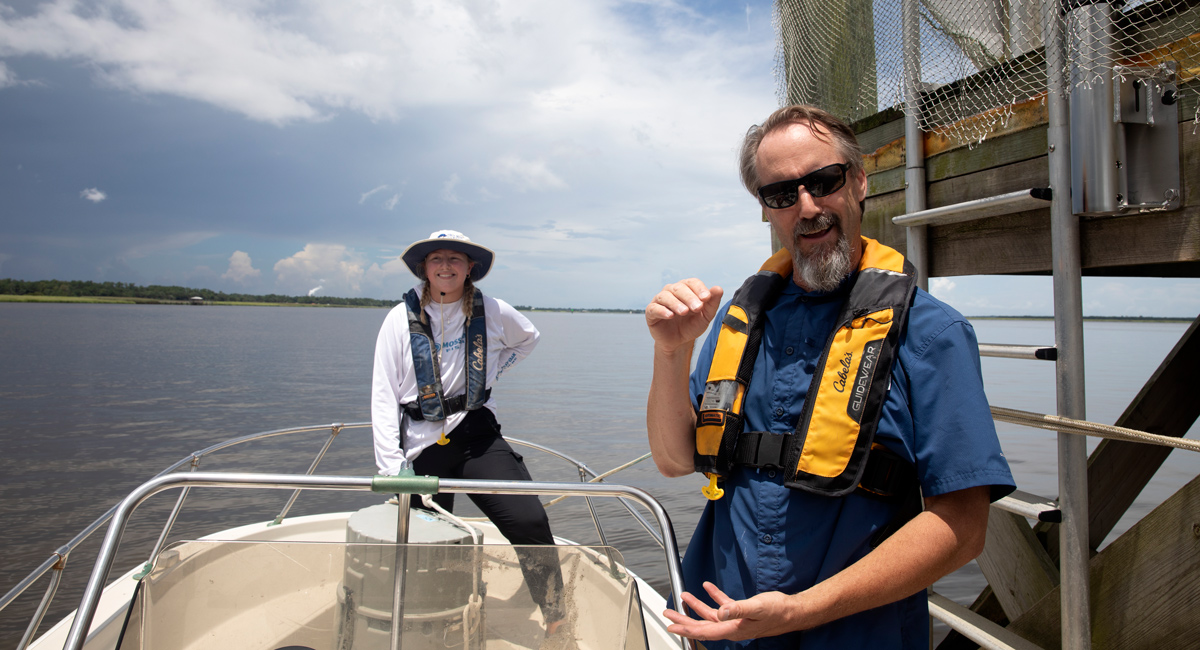
Camille Wheeler, a senior studying marine science, and researcher Erik Smith collect samples that measure the water quality in Winyah Bay.
Camille Wheeler
Camille Wheeler, a senior studying marine science, remembers when she first heard about the university’s coastal field lab. She was a high school student from Massachusetts touring UofSC with her father, when a faculty member in the School of Earth, Ocean and Environment took the time to meet with her one-on-one and discuss the program’s offerings.
“It was really cool to have somebody sit down and explain to me what I would be doing all four years. I mean, no other schools did that,” Wheeler says. “And when she told us about Baruch, my dad and I both thought that was really awesome, because not everywhere has access to a field lab.”
Fast forward four years, and Wheeler is in a boat on Winyah Bay, about to climb onto a platform to retrieve an instrument that helps measure water quality. She splits her time between fieldwork in the waters around Baruch and analyzing samples and data in the lab.
One of her projects was assessing reliability of a probe that collects information about water in fast increments — providing a reading of water quality every two seconds. It allows researchers to have access to huge amounts of data, enabling them to see the impact of changes in tides, seasons, weather and other factors. The work also is trying to determine if there are any interferences with the probe that would affect the data. Similar work is being done at other reserves around the country.
“The best way to learn is kind of just jumping right in and seeing what you can do.”
“We're looking specifically at chlorophyll, which is really important for looking at ecosystem health,” she says. “If there is a high frequency monitoring of chlorophyll levels, it can allow us to look at trends really closely.”
If the research on the probe determines it is reliable, then researchers will develop a protocol for implementation at all 29 National Estuarine Research Reserves across the country.
Once the samples are collected from the water quality observation sites, they go back to the lab for chlorophyll extraction, followed by processing and statistical and data entry.
Like several other students at Baruch for the summer, Wheeler is planning a career in research, and used the time to make sure that’s the path she hopes to follow.
“I thought this would be a good experiment this summer to see if I would really be interested in pursuing this in the future. And I also would get experience of what the whole process is actually like,” she says. “Here, even though Erik (Smith) is obviously the head of the project, he gives me a lot of freedom in designing my days and I get a lot of input into what I think might work well with the project. It's a lot more freedom than I expected, which I really, really like. The best way to learn is kind of just jumping right in and seeing what you can do.“”